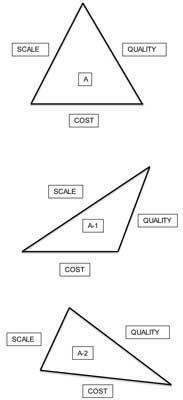Iron triangle model
Introduction
“At sector and institutional levels the notion of an iron triangle for education has been posited, linking firstly access, quality and cost (and latterly accessibility, quality and efficiency) in order to suggest means of using open, distance and e-learning (ODeL) and/or OER for widening access to higher education for the same or lower cost without compromising outcomes (Immerwhar et al, 2008; Daniel and Uvalic-Trumbic, 2011; Mulder, 2013)” Lane, 2014
Figure "The Iron Triangle of Education" (below) shows the basic triangle originally defined by Uvalic-Trumbic (2011) according to Lane (2014).

Each factor - scale, quality and cost - are represented by equal length sides. “The assumption is that increases in one point of the triangle will inevitably lead to stresses in the other points. [...] These changes make the basic point that with conventional teaching in classrooms there is little scope to alter these factors advantageously because improving one factor will worsen the others. Pack more students into the class and quality will be perceived to suffer (Figure 1- A1). Equally, try to improve quality by providing more learning materials or better teachers and the overall cost will go up (Figure 1- A2). In effect the area under the triangle does not change because of these physical limitations.” (Lane, 2014).
Bibliography
- Daniel, J. and Uvalic-Trumbic, S. 2011 The impact of new business models for higher education on student financing. Financing Higher Education in Developing Countries Think Tank. 8–12 August, 2011, Bellagio Conference Centre, Las Vegas retrieved from http://www.col.org/resources/speeches/2011presentation/Pages/2011-08-08.aspx.
- Immerwhar, J., Johnson, J. and Gasbarra, P. 2008 The Iron Triangle: College Presidents talk about costs, access and quality. available at http://www.publicagenda.org/files/pdf/iron_triangle.pdf.
- Lane, A 2014. Placing Students at the Heart of the Iron Triangle and the Interaction Equivalence Theorem Models. Journal of Interactive Media in Education 2014(2):5, DOI: http://dx.doi.org/10.5334/jime.ac
- Mulder, F. 2013 The LOGIC of National Policies and Strategies for Open Educational Resources. International Review of Research in Open and Distance Learning 14(2): 96–104.